
Given that most people can only see about 5% as well at night as during the daytime, it is perhaps not surprising that most traffic accidents occur at night. Moreover, most nighttime single-vehicle accidents occur when no additional light sources are present, with only the vehicle's headlights available to light up the road ahead. However, and somewhat strangely, automotive head light technology has not quite kept pace with other developments, and while there are some exceptions to this on some ultra-high-end vehicles, most drivers in Australia (and elsewhere) still depend on headlight technologies that are about 50 years old.
Thus, to shed some light on the issue of insufficient headlights on modern vehicles, in this article we will discuss current headlight technologies in terms of how they produce light, and what we can expect in terms of emerging headlight technologies, one of which uses more than a million mirrors to focus the light beam. Let us start with a brief history of-
By the time Henry Ford introduced moving assembly lines to mass-produce his Model T cars in 1913, headlights in one form or another had been in widespread use by almost all the car manufacturers of that time.
However, unlike the multitude of “weird” ideas that served as the basis from which to develop technical engineering solutions to increase the efficiency and reliability of cars, headlights in the early 20th century were still simple lanterns that burned a variety of fuels, some of which were kerosene (paraffin) and acetylene. While acetylene lanterns produced more light than kerosene lanterns, generating acetylene gas involved dumping a lump of calcium carbide into a tank of water that did not form a part of the "headlight unit".
Therefore, to turn on the headlights, a driver or “motor operator” had to start the gas generation process, and then open a shut-off valve in a gas line for the gas to reach a burner in the lantern. The light thus produced was directed forward by a reflector, and according to some accounts, a well-maintained acetylene lantern could produce a beam of light that “penetrated the darkness for a distance of 10 to 12 steps”. However, in freezing temperatures, the water in the storage tank froze, which rendered the lanterns useless unless a quantity of pure alcohol was added to the water to prevent the water from freezing.
By 1912, however, Cadillac and Rolls-Royce introduced (recently invented) electric light bulbs (and engine-powered DC generators to supply the electricity) to replace gas-powered headlights on their vehicles. The bulb was placed between a reflector and a glass lens, and while this development outperformed all other lighting systems by a huge margin, these electric lights had a very short lifespan because the reflective surface on the reflector corroded relatively quickly. This had the effect of producing a halo of light, instead of a focused beam, which not only reduced the efficacy of the light unit but also tended to blind oncoming drivers.
We need not delve into the minutiae of headlight development any deeper, beyond saying that in the period between 1912 and the early 1920s, many manufacturers introduced batteries, electric starters, and generators on their new models, which provided the technological foundations for further developments in headlight technology.
The first such major advance came in 1919 when Bosch invented an electric bulb with two filaments, each filament capable of producing a beam of light independently of the other filament. By this time, the number of cars (in the USA) increased almost exponentially, and their single-beam headlights became a major safety concern because increasingly more accidents started to occur because of drivers blinding each other at night.
At the same time, Bosch also invented what was called a “dip-switch” to control the two filaments. These switches were typically mounted on the dashboard, which allowed drivers to easily select between a "high beam" that produced a relatively tightly focussed beam of light from the primary filament that illuminated the road for about 50 metres or so and a "dipped beam" from the secondary filament.
The dipped beam did not only produce noticeably less light, but its location in the headlight unit relative to the reflector also changed the angle of the light beam to below an oncoming driver’s line of sight, thus preventing the oncoming driver from being blinded. By 1927, dashboard-mounted dip switches were replaced by foot-operated floor-mounted switches as a safety measure to reduce the number of distractions drivers were dealing with even then.
However, despite extremely rapid advances in automotive technology that began in the late 1920s, headlight technology stagnated until the widespread introduction of sealed-beam units between 1936 and 1939, which eliminated the problem of corrosion on headlight reflectors. Moreover, while sealed beam headlights using conventional incandescent bulbs have largely fallen out of favour, the basic design of headlights on many applications, i.e., an electric bulb placed between a reflector and a glass lens has not changed significantly, although some clever tweaks have made the basic design much more effective, which begs this question-
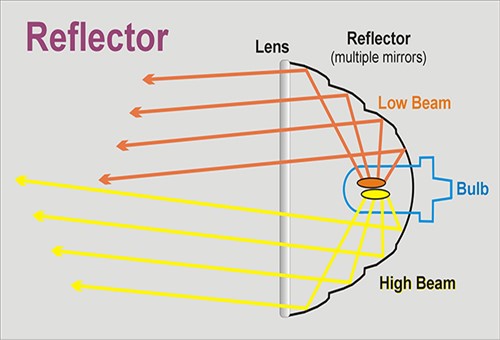
This simplified diagram shows the basic operation of all headlight systems that use either conventional or halogen light bulbs in conjunction with a reflector. We don't need to spend too much time discussing the technical details of this type of headlight, beyond saying that the refraction (bending) of light forms the "cornerstone" of the operation of this type of headlight.
In practice, the refraction of light can be achieved in one of two ways, although in all cases, the purpose is the same, which is to focus the light in a pattern that a) provides the sharpest focus of the beam, b), to illuminate the longest and widest section of the roadway without blinding oncoming drivers.
This might seem like a tall order, but by adhering to some basic principles of optics, both objectives can be achieved by-
Which method is applied to any given vehicle depends as much on the design of a vehicle as it does on the cost of producing a headlight. For instance, on vehicles such as some sports cars, on which the shape of the headlight lenses is an integral part of the vehicles’ overall design, light refraction typically occurs on the reflector to maintain/enhance the overall appearance of the vehicle. On more mundane vehicles, it hardly matters if the glass lens is disfigured with raised bumps, lines, or dots- provided the light beam is focussed properly.
Consider the image below-
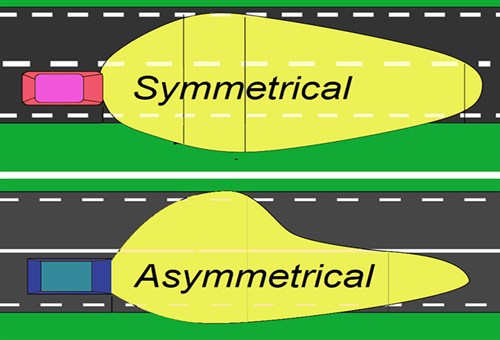
Image source: https://img.vehicleservicepros.com/files/base/cygnus/vspc-sap/image/2020/08/3-s-and-a-beam.png?auto=format&fit=max&w=1440
Up to about 1950, all headlights produced a symmetrical light pattern as shown in the panel above. By this time, however, regulatory authorities in particularly the USA began to recognize the dangers of headlights that blind oncoming drivers, and began a process of mandating changes to headlight designs that reduced glare for oncoming drivers.
We need not delve into the minutiae of this legal process here, beyond saying that it was around 1950 that the process of using multiple reflective planes in headlight units to deflect emitted light began in earnest. The object of the mandated changes was to deflect light in an asymmetrical pattern, i.e., away from oncoming traffic, and while some designs were effective at doing this, others were less so.
Nonetheless, many of the headlights in current use still use light refraction as the basis of their operation, but comparatively recent advances and developments in headlight technology are increasingly obviating the need for complex reflective surfaces to focus and/or direct light beams. Let us look at some of these developments in some detail, starting with-
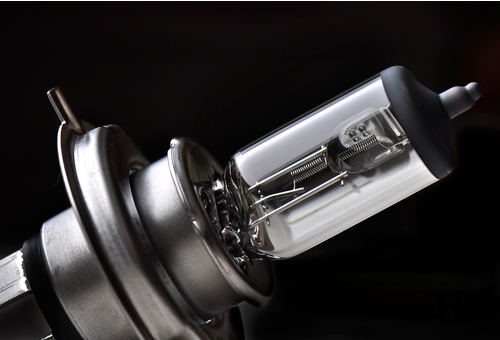
This image shows a double-filament halogen headlight bulb, and while these types of bulbs are not exactly new, since they were introduced as long as ago as 1962, many of the features on modern halogen bulbs are relatively new.
In terms of operating principles, halogen bulbs use filaments made from tungsten-based alloys to produce light, but unlike conventional incandescent bulbs in which the filaments are heated in a vacuum, halogen bulbs are partially filled with halogen gas. The actual process that produces light is a complex chemical one, but in simple terms, the filament heats the gas, which then reacts with molecules on the surface of the filament to superheat the filament.
This process produces not only almost three times the amount of light that even the most advanced incandescent bulbs can produce, but the halogen gas around the filament also insulates the filament against secondary chemical reactions, which extends the service life of a typical halogen bulb to at least twice that of an incandescent bulb.
Moreover, the biggest advantage of halogen bulbs over incandescent bulbs is that much of the focussing of the light beam can be achieved by incorporating mirrors, reflectors, shields, and cut-off devices into the bulb itself. Doing this not only reduces the cost of producing headlights but also makes it easier to integrate the design of headlights into the overall design of the vehicle.
HID (High-Intensity Discharge) headlights, also, are not exactly new seeing that they were first used on 1991 8-Series BMW models. Unlike halogen and incandescent bulbs that use heated metal filaments to produce light, HID lights use high-voltage electric arcs in an inert gas like xenon to generate light.
This type of light is also used in applications that include street lighting, but in these applications, the preferred inert gas is typically a form of halide that is derived from various metals. However, these gases typically have long reaction times, which makes them unsuitable for automotive use.
Thus, starting in 1991, BMW began using xenon gas to fill their HID light units, since this gas reacts almost instantly with the electric arc. However, what is new, is the various proprietary gas mixtures different manufacturers use not only to produce more light but also to both increase reaction times and reduce the initial inrush voltage required to trigger* the electric arc, with the triggers supplied by dedicated ballast resistors and computer-controlled igniters.
*Modern HID lights can be triggered by currents as low as 18 000V, which is a significant reduction from the more than 40 000V that was required to trigger the electric arc in HID lights of just ten years ago.
In practice, this triggering current and its effects are roughly analogous to how a capacitor starts an induction motor, and as with a capacitor that starts an electric motor, the high current is removed once the electric arc between tungsten or wolfram electrodes in the light unit is established. Once light production is stable, the electric arc uses about the same (or less on some designs) amount of current than a typical halogen requires to work.
In addition to their low power requirements relative to the intensity of the light they produce, HID lights also have the advantages that they have service lives above 2000 hours of continuous operation, and that the focussing and directing of the light beam can be determined solely by the profile and curvature of a single lens.
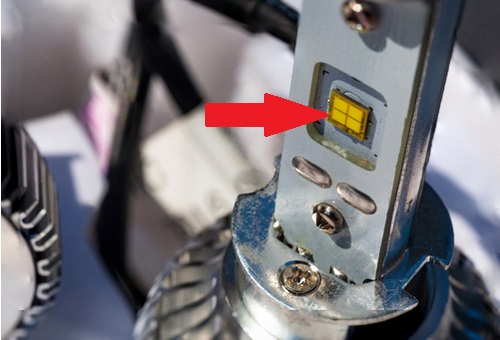
While LED lights like the one shown here have been in use for a few years, their use is still largely confined to high-end, luxury vehicles and some supercars. Note the red arrow here that indicates the light producing elements.
LED lights employ solid-state electronics and a semiconducting material that emits light when a current flows through it with the amount of light thus produced depending on both the current and the purity of the semiconducting material. Therefore, assuming that the best possible material is used for a given automotive application and the current is within specifications for that application, an LED headlight bulb will operate continuously for at least 8000 hours.
In practice, LED lights produce light purely through the excitation of electrons in the semiconducting material, and therefore, the light producing-elements cannot "wear out" through the loss of electrons, which is the mechanism that causes metal filaments in bulbs to fail after they have lost a critical amount of electrons by being heated to super-high temperatures over extended periods.
Nonetheless, while LED lights are at least 80% efficient (in producing light), the single biggest disadvantage of LED lights is the fact that the light produced has to be focussed and directed with a complex arrangement of internal mirrors, reflectors, shields and cut-off devices. In fact, in some applications, the arrangement of optical elements in the headlights is so complex that the headlights have to be calibrated along with several ADAS systems after windscreen replacements or even minor front-end collision repairs.
The laser-based headlights that were introduced on some 2014 BMW and Audi models were not so much an innovation in headlight technology as it was a repurposing of existing industrial technology.
The problem with lasers is that they emit an extremely tightly focussed beam of light, which makes lasers unsuitable for use as headlights unless the beam of light is de-focussed and diffused to cover a wider area. To do this, the first iteration of laser lights used three diodes to generate three discrete blue laser beams that were passed into a prism to both amplify and combine the three beams into a single beam.
The combined beam of light was then passed through a lens coated with a phosphorus-based coating that changed the beam's colour to white. The white light was then directed to a reflective surface that diffused the beam somewhat, before directing it onto the road surface. However, despite the technical difficulties in stabilising the prism relative to the reflective surface, laser-based headlight systems are roughly 30% more efficient than LED-based systems and can project relatively tightly focussed light beams up to about 2000 metres, which is twice as far as LED-based light beams.
The latest iteration so laser-based headlights use only a single laser diode, which makes it possible to reduce the dimensions of laser modules, and by extension, the dimensions of laser-based headlight units by a factor of ten, compared to even the most compact LED-based headlights available today. Nonetheless, despite the efficiency and effectiveness of laser technology, the use of lasers in headlights will likely not become commonplace on the majority of vehicles due to their high cost which brings us to-
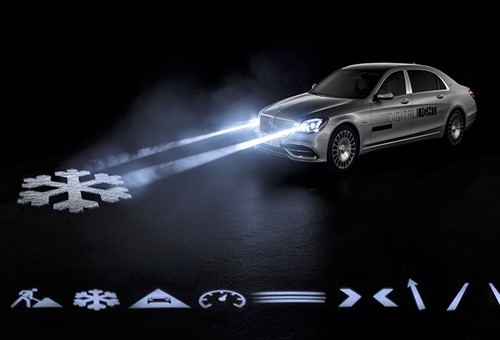
Image source: Daimler Group
This image shows the headlights on an actual 2018 Mercedes-Maybach S-Class sedan projecting a bad-weather warning in the form of a snowflake directly onto the road surface. The symbols along the bottom of the frame include a few of the other possible symbols this lighting system can project onto the road to warn drivers of a) dangerous conditions ahead, or b), to inform drivers of things like changing speed limits, upcoming curves in the road, and even the presence of pedestrians along the road.
This system was developed by Marelli Automotive Lighting and is known as the h-Digi®, or more properly, the Digital Micro-mirror Device. The system uses three high-current LEDs to produce a light beam that is focused and directed with 1.3 million mirrors in each headlight unit via V2I (Vehicle-to-Infrastructure) technology, which is already in operation in some locations around the world.
In practice, each of the 1.3 million (10-micron-wide) mirrors in each headlight can be individually controlled with a microprocessor to automatically focus and direct the light beam in such a way that even multiple oncoming drivers are not blinded, and leading drivers are not affected by glare from their rear-view mirrors. Moreover, by manipulating only some of the mirrors, some of the light can be “tapped off” and projected onto a small screen in the light units to produce the warning and informational symbols as shown above.
While similar warning systems are already in use on several makes and models, this information is typically projected onto the windscreen as heads-up-displays, but with the h-Digi® system, the image is projected directly into the driver’s line of sight on the road surface to reduce the amount of information on windscreen displays that many drivers find to be distracting.
However, h-Digi® lighting is currently only available on a few ultra-high-end Mercedes-Maybach and Audi models that are made to order. This fact explains why there is no real technical information available on power consumption, details about service and/or replacement procedures, or perhaps, more importantly, indications on how many tens of thousands of dollars these systems add to the basic price of a high-end luxury vehicle, which leaves us with this-
While headlights may have lagged behind other automotive technologies, headlights have now not only evolved into an advanced stand-alone technology- headlights and their technological underpinnings are now increasingly being incorporated into ADAS systems such as forward-looking cameras that support adaptive cruise control, forward collision mitigation, autonomous braking, and others.
Thus, from our perspective as technicians, headlights are no longer just about lighting up the road at night or in poor visibility: headlights are now fast becoming the proverbial cornerstone of a range of technologies whose combined purpose it is to compensate as much as possible for the 95% of visual acuity drivers lose at night. Therefore, it is our responsibility as technicians to learn as much about modern headlight technology as we can not only to ensure the safety of our customers, but also to leverage the economic opportunities that come with maintaining, servicing, calibrating, or replacing modern headlights.